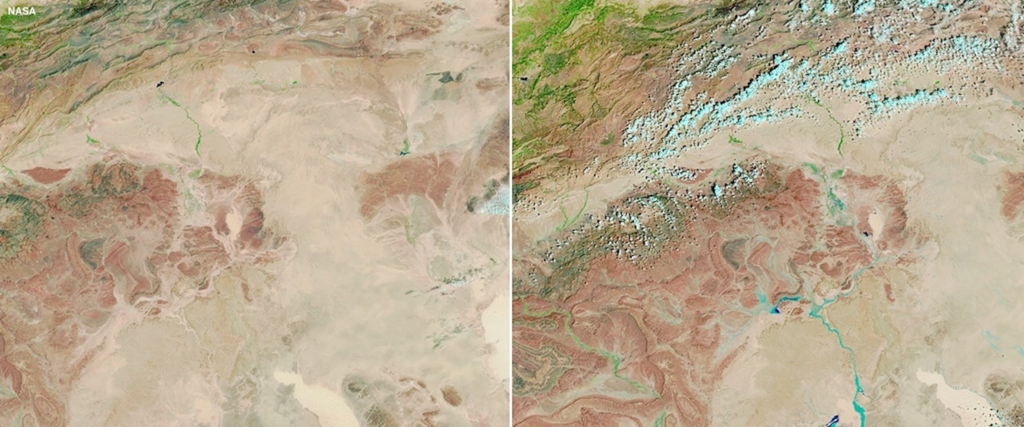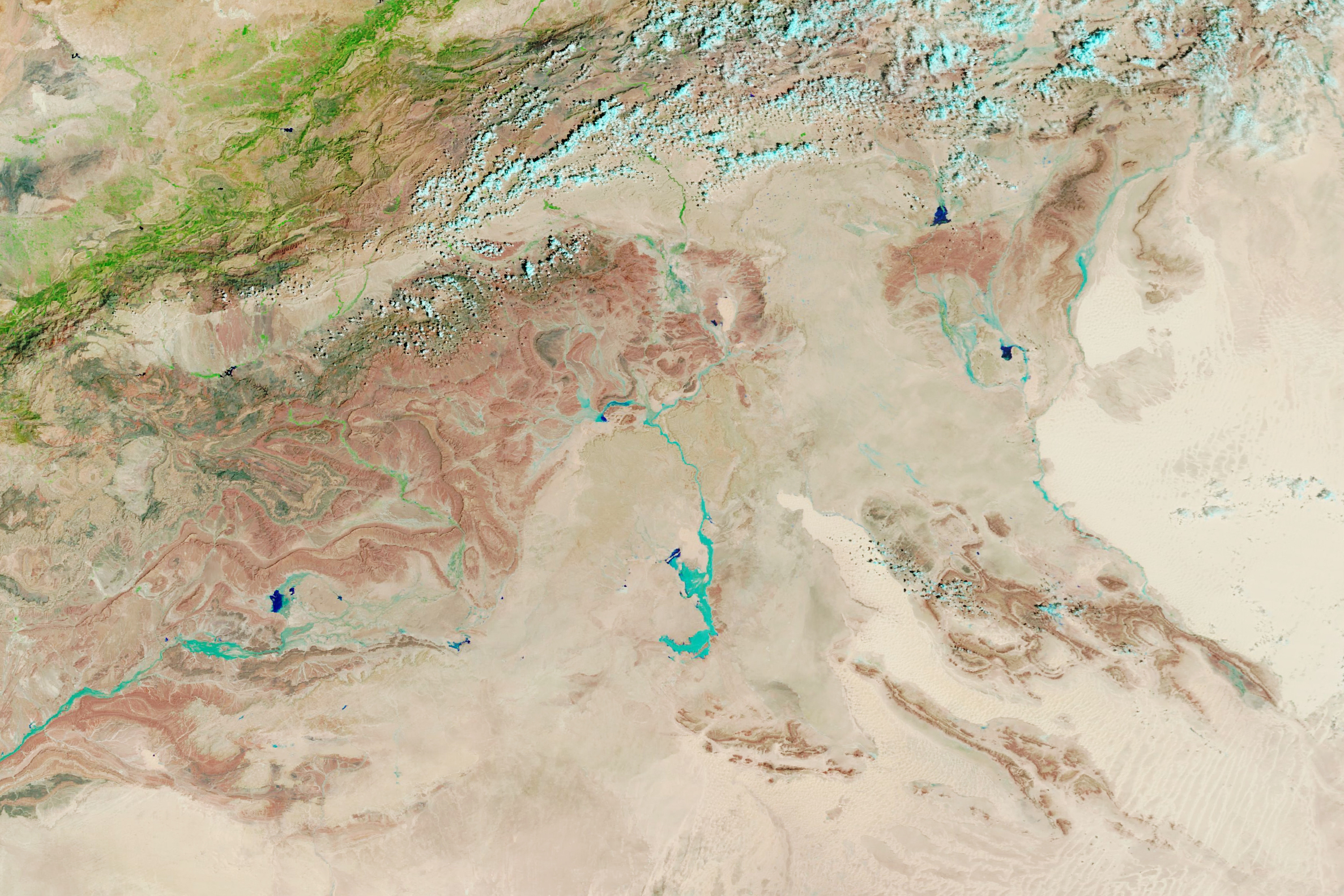Sahara Desert Turning Green from Arid Yellow on Recent Pic Shared by NASA. The Sahara Desert, known for its vast stretches of arid yellow sands, is undergoing an extraordinary transformation.
Satellite images captured by NASA reveal a rare and unexpected phenomenon—parts of the Sahara Desert turning green. This sudden greening is attributed to heavy rainfall in the region, marking a dramatic change in one of the world’s driest landscapes.
The phenomenon of the Sahara Desert turning green is not something witnessed every year. In fact, this year’s unusual weather patterns have resulted in some areas of North Africa receiving as much as five times the average rainfall for September.
The normally barren and dry expanse is now spotted with patches of vegetation and water accumulation, presenting a rare sight for one of the world’s most notorious deserts.
The Science Behind the Sahara’s Transformation
The sudden Sahara Desert turning green is largely due to an extratropical cyclone that passed over the region in early September. From September 7 to 8, the desert saw heavy rainfall, which brought as much as a year’s worth of precipitation to certain areas, including parts of Morocco and Algeria.
This deluge was so intense that the floodwaters filled several of the desert’s normally dry lakes, giving rise to a rare view of water bodies amidst the sands.
Read : Western Sahara: The Desert’s Silent Struggle for Sovereignty
According to NASA’s Moderate Resolution Imaging Spectroradiometer (MODIS), the extratropical cyclone drenched significant portions of the Sahara, resulting in a visible transformation of the landscape.
While the Sahara Desert typically receives only a few inches of rainfall per year, these recent downpours have left behind a massive amount of runoff water, changing the entire complexion of the region.
Read : In the Heart of the Barren: Ranking the Top 10 Largest Deserts Worldwide
The satellite images of the Sahara Desert turning green were shared by NASA and confirmed by the Earth Observatory. They revealed large bodies of water that formed after the thunderstorms, with different shades of blue representing the depth of the water. The green patches, on the other hand, indicated the presence of newly sprouted vegetation.

How Rainfall Impacts the Sahara
The Sahara is known for its extreme dryness, with most areas receiving less than four inches of rain per year. However, the recent occurrence of the Sahara Desert turning green due to heavy rainfall is a reminder of how weather patterns can shift even in regions we typically consider unchanging.
The Sahara, which spans nearly 9.2 million square kilometers, plays a crucial role in shaping the climate of North Africa and beyond. When heavy rainfall strikes, it not only alters the desert itself but also has wider implications for surrounding ecosystems.
This time, it was the Intertropical Convergence Zone (ITCZ) that played a major role in the Sahara Desert turning green. The ITCZ is a belt of weather near the equator where winds from the Northern and Southern hemispheres meet.
This zone can carry storms, and this year, it shifted toward the northern part of the Sahara. As a result, rainfall in the desert increased significantly.
Another contributing factor to the Sahara Desert turning green is the unusually warm water in the North Atlantic Ocean and the Mediterranean Sea. Warmer waters often lead to increased evaporation and, consequently, more moisture in the air, which can result in heavier rainfall. This is what scientists believe happened this year, causing the desert to receive an unexpectedly large amount of rain.

The impact of this rainfall has been most clearly seen through NASA’s satellite images, which show rain accumulation in the desert. The Joint Polar Satellite System (JPSS) captured images on August 30 and September 9, 2024, using enhanced color to highlight areas where water had gathered.
Clouds were shown in light cyan, while the water, shown in dark blue, indicated moisture levels. The greening effect in some parts of the desert was unmistakable, with patches of vegetation appearing where only dry sand had been before.
A Glimpse into the Future: More Rain in the Sahara?
With the Sahara Desert turning green this year, the big question is whether this phenomenon will continue. While the desert has always experienced sporadic rainfall, the extent of this year’s precipitation is rare.
According to scientists, the region could experience more rain in the coming years, particularly if weather patterns like the ITCZ continue to shift or if ocean temperatures continue to rise.
NASA’s Earth Observatory has reported that since the time weather records have been maintained, there have been more than 38,000 incidents of extreme rainfall over the Sahara. Interestingly, nearly 30 percent of these events occurred during the summer, often associated with extratropical cyclones like the one that drenched the desert in September.
As weather systems continue to evolve, it’s possible that the Sahara could see more instances of greening in the future. However, it’s important to note that the current greening is temporary. While vegetation may sprout after heavy rains, the desert’s harsh climate means that the newly-formed greenery is unlikely to last for long.
Nevertheless, the sight of the Sahara Desert turning green offers a rare glimpse of the desert’s potential to change. While it may be fleeting, this transformation is a reminder that even the most unyielding landscapes can be altered by nature’s forces.
The Impact of the Transformation on Local Ecology
While the Sahara Desert turning green is certainly a spectacle, it also has important implications for the local ecology. The desert’s harsh conditions usually limit plant life, but after heavy rains, plants that have adapted to the desert’s extremes can quickly take advantage of the moisture.
These plants often grow rapidly, producing flowers and seeds before the water evaporates. This short-lived burst of life provides a temporary boost to the desert’s ecosystem, supporting animals that rely on plants for food.
However, this influx of moisture can also pose challenges. Floodwaters can disrupt the desert’s fragile ecosystem, displacing animals and even leading to erosion in some areas. As the water recedes, the ecosystem will have to adjust once again to the arid conditions.
For the people living in and around the desert, the transformation offers a unique opportunity. Agriculture is difficult in the Sahara, but when rainfall increases, it can provide a brief window for farmers to grow crops.
In some parts of North Africa, farmers have taken advantage of these rare rainfalls to plant crops like millet and sorghum. However, as with the vegetation in the desert itself, these opportunities are often short-lived.
The rare occurrence of the Sahara Desert turning green has fascinated scientists and the public alike. NASA’s satellite images have captured this transformation in stunning detail, showing how heavy rainfall has brought life to a region that is usually barren.
While the greening of the Sahara may be temporary, it serves as a reminder of the ever-changing nature of our planet’s climate and ecosystems.
As scientists continue to monitor the situation, there is hope that more rainfall in the Sahara could benefit both the local ecology and the people who depend on the desert for their livelihoods. For now, the images of the Sahara Desert turning green will remain a rare and captivating glimpse into one of the world’s most fascinating landscapes.

